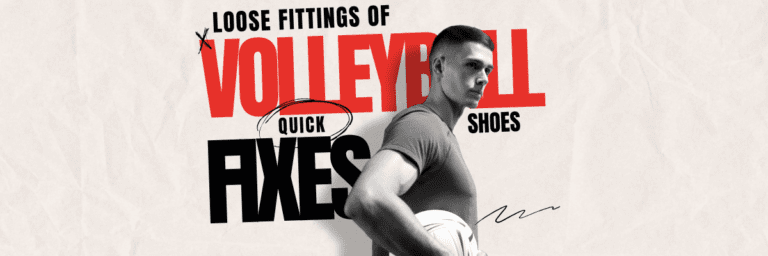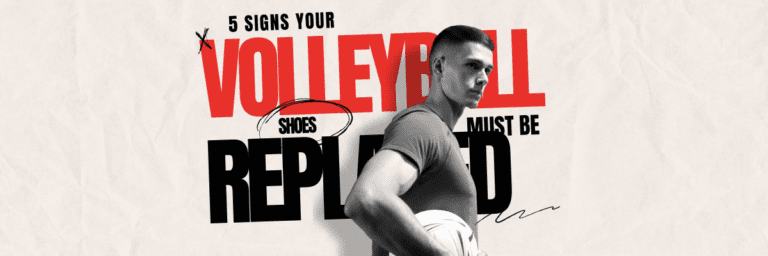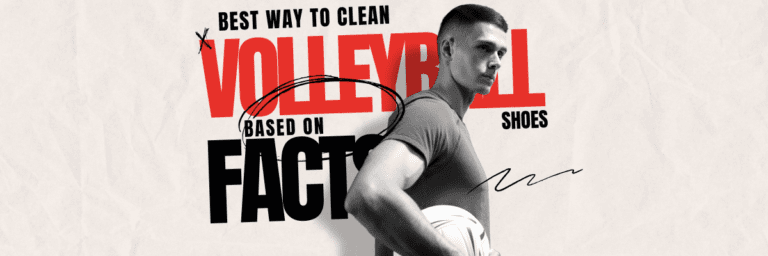How Tight Should Your Volleyball Shoes Be? A Maintenance Perspective
Introduction
An Uncomfortable Misstep Could Lead to a Blunder on the Court
We’ve all experienced the situation where you’re in the middle of a tense volleyball match and suddenly feel like a boa constrictor is squeezing your feet. You try to ignore it and make a jump serve, but oops, there you go, stumbling like a toddler learning to walk. You could’ve been a star, but your shoes had other plans.
Importance: The Game-Changing Power of Proper Tightness
Now, let’s get real for a sec. Those little details, like how tight your shoes are? They’re not so little when you’re aiming for that perfect spike or dig. You wouldn’t believe how much your game can improve by just tweaking the snugness of your volleyball shoes. And it’s not only about your performance; your foot health is at stake too. Don’t let your shoes put a crimp in your style or your game!
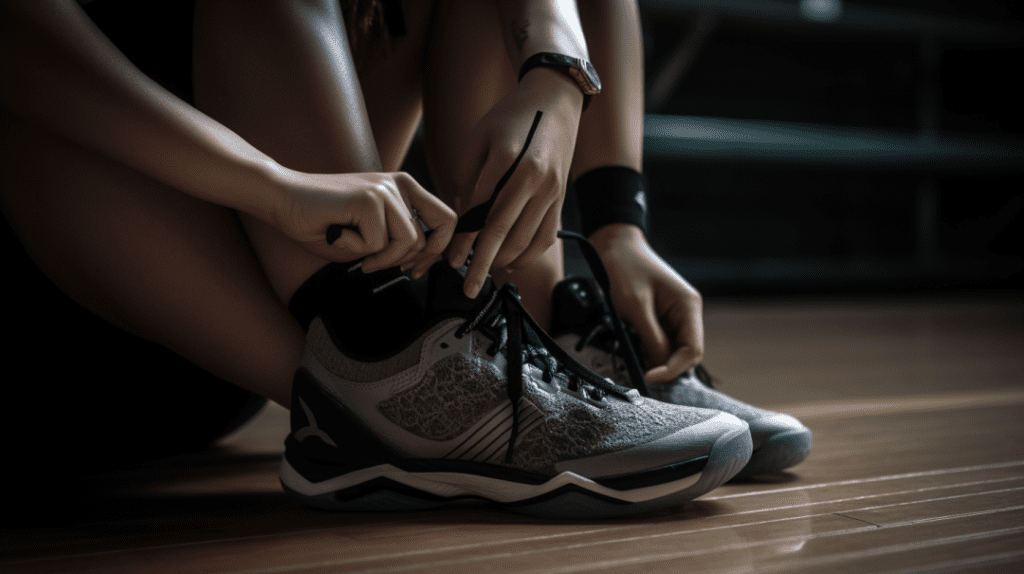
Scope: Not Just Tightness, but Tightness with Finesse
But wait, there’s more! We’re not just going to talk about finding the perfect Cinderella fit. We’re diving deeper into the nitty-gritty world of shoe maintenance. That’s right! This article is your one-stop guide to achieving and maintaining that elusive “just-right” tightness level, all while maximizing the lifespan of those pricey volleyball shoes.
The Anatomy of a Volleyball Shoe
Material: It’s Not Just About Looking Cool
Ever looked at your volleyball shoes and thought, “What are these babies made of?” No? Just me? Well, whether you’ve pondered this or not, the material of your volleyball shoes is crucial. Commonly, they’re made of a synthetic mesh material, light enough for those gravity-defying jumps yet durable enough for those rough landings.
Some higher-end models even sport a leather finish for that extra oomph. And why does the material matter? Because it affects breathability, flexibility, and, oh yeah, how easy they are to clean! So, the next time you shop, don’t just go for the snazzy colors; check the material too.
Design Aspects: More Than Meets the Eye
Alright, let’s get to the fun stuff: the nifty design aspects that make volleyball shoes your best pal on the court. For starters, let’s talk arch support. This feature is like that trusty friend who’s always got your back, or, in this case, your sole. Good arch support equals better stability and less foot fatigue. Can I get a “Heck yeah!”?
Next up, cushioning! Imagine landing a killer jump serve; you want to feel like you’re landing on clouds, not bricks, right? That’s where cushioning steps in. The extra padding absorbs shock, making those high-impact moves a piece of cake. Well, maybe not “cake,” but you get the idea.
Now, let’s not forget about ankle stability. We all know that one player who’s a little too daring with their dives. Don’t be that guy or gal. A proper volleyball shoe comes with built-in ankle support to help you avoid the dreaded sprain or, worse, a fracture. So, unless you fancy a trip to the ER, pay attention to that ankle support!

Why Tightness Matters
Performance: Slip or Grip, Your Choice
Ah, the age-old question: how tight should your volleyball shoes be? If you’re thinking, “Eh, as long as I can get my foot in, we’re good,” But no! Proper tightness is like the secret sauce to your performance on the court. Too loose, and you might as well be playing on ice; you’ll be slipping and sliding all over the place.
On the other hand, a snug fit enhances your agility, making you the ninja of volleyball courts. I mean, who doesn’t want to jump higher, run faster, and land safer? So, the next time you’re tying those laces, remember: A snug shoe is your ticket to becoming the MVP.
Health Implications: Don’t Footsie Around with This
Now let’s get serious for a sec. Your foot health is no joke. Get your shoes too tight, and you’re looking at a one-way ticket to Blister Town. Population: You. Blisters may sound harmless, but let’s face it, they’re the nagging in-laws of foot problems; they’re annoying and just won’t go away easily. But wait, there’s more! Shoes that are too tight can also cause foot pain and put you at risk for conditions like plantar fasciitis.

Oh, and don’t even get me started on sprains. Playing in loose shoes is like doing cartwheels on a tightrope; it’s risky business, my friend. You could end up rolling your ankle, and voila, you’re benched for the rest of the season. And who wants to spend volleyball season warming the bench? Definitely not me, and I bet not you either.
Understanding the Perfect Fit
The “Thumb Rule”: Get a Grip, Literally!
Let’s start with something so simple; it’s genius, the thumb rule. Nope, we’re not talking about social etiquette or unspoken laws; this is way more fun and hands-on. To check if your shoe is the perfect fit, slide your thumb between your biggest toe and the tip of the shoe.
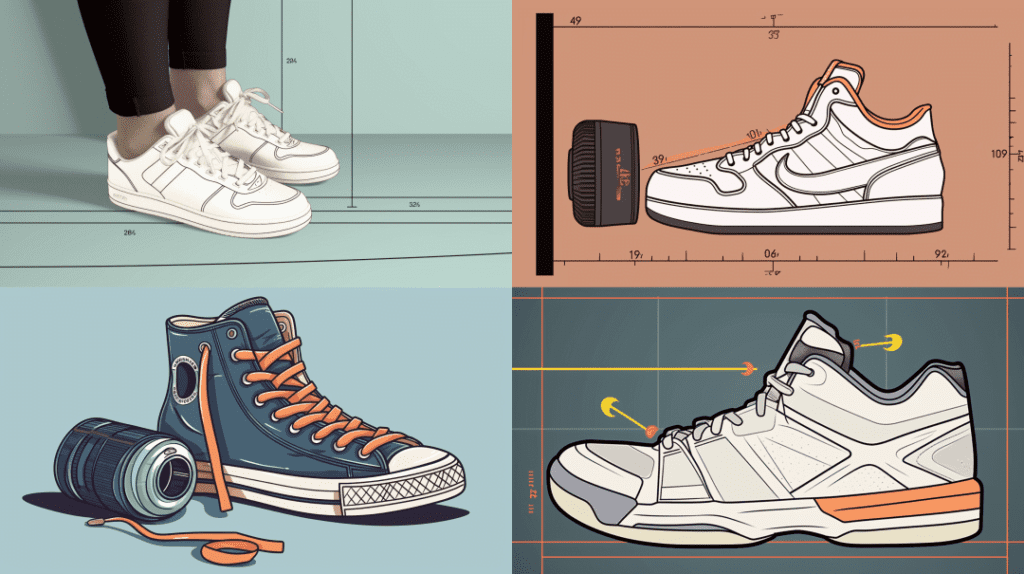
Your thumb should fit snugly, but not too tight or loose. If it’s a battle to get your thumb in there, your shoes are too tight, my friend. On the flip side, if there’s room for a thumb party, those shoes are way too loose.
Foot Shape: One Size Doesn’t Fit All, Pal
The shape of your foot is like your fingerprint—unique and kinda weird if you look closely. So it makes sense that not every volleyball shoe will be a match made in heaven for your feet. For instance, some people have wider feet, while others could pretty much audition for Cinderella.
Your foot’s arch also plays a significant role. Low arches require better support; otherwise, you’ll feel like you’re walking on hot coals. In contrast, high arches need cushioning to feel like you’re literally on cloud nine. So next time you’re shoe shopping, don’t just consider size; think shape!
Socks Factor: The Unsung Hero of Tightness
Ah, socks, the underdogs of the sports world. You may not realize it, but the type of sock you wear can make or break your game. Thin socks might leave you with shoes that are too loose, turning you into Bambi on ice. Thick socks, however, could make those shoes feel like a straightjacket for your feet.
And let’s not even talk about moisture-wicking socks; those bad boys can change the entire tightness equation. So, when picking out socks, it’s not just about what matches your uniform; it’s a science!
Maintaining the Ideal Tightness
Pre-Game Rituals: Because Even Shoes Need a Warm-Up!
Alright, you’re pumped, you’re ready, and you’re about to hit the volleyball court like a storm. But wait, what about your shoes? Pre-game rituals aren’t just about mental prep; they’re about getting those bad boys on your feet, ready for action. So, tighten the laces in a crisscross fashion for a better fit. If your shoes have a tongue lock, make sure it’s fastened without squeezing the life out of your foot. A quick jog around the locker room can also help you gauge the tightness level. Too tight or too loose? Adjust right there and then.

In-Game Checks: No Timeouts for Tightness Troubles
Once the game kicks off, you’re pretty much in the zone. But hey, it doesn’t hurt to keep an eye, or rather, a toe, on your shoe tightness. If your shoes start feeling a tad loose or a pinch too tight, use the timeouts or breaks to make quick adjustments. A double knot here, a loosened eyelet there, and you’re back in business. We’re talking about seconds, but those few seconds can make a world of difference to your game and comfort.
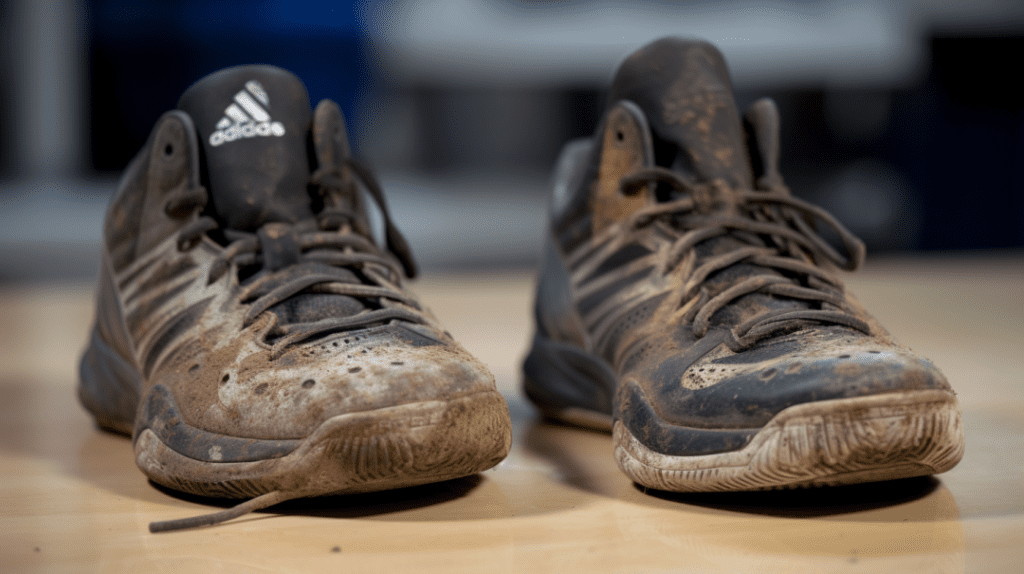
Post-Game Care: After the Applause, Comes the TLC
Victory or not, your shoes have been through the wringer and deserve some TLC (tender, loving, and care, in case you’re wondering). Start by loosening the laces and removing the shoes with care, not like you’re pulling weeds from a garden.
Wipe off any dirt or sweat; these things can affect the shoe’s material and, subsequently, the tightness. If you’ve had an intense game, consider using shoe fillers or trees to maintain the shape. Store them in a cool, dry place, and they’ll be raring to go for the next match.

Expert Tips and Tricks
Not Too Loose, Not Too Tight: Wisdom from the Pros
When it comes to volleyball shoe tightness, finding that Goldilocks zone, where it’s not too loose and not too tight, is the ultimate goal. But don’t just take our word for it; let’s hear from the experts themselves.
Dr. Sandy Acevedo, a sports medicine specialist, emphasizes,
“The right tightness in your volleyball shoes can significantly impact your game. Too loose, and you risk instability; too tight, and you’re inviting discomfort and potential injuries. It’s about striking that balance.”
And Coach Alex “Ace” Rodriguez, a seasoned volleyball coach with multiple championships under his belt, adds,
“I’ve seen it all on the court. Players with shoes as loose as flip-flops and others with shoes so tight they could barely wiggle their toes The best performers are those who pay attention to their shoe tightness. It’s like having the perfect tool for the job.”
So there you have it, straight from the pros’ playbook. The consensus is clear: finding that sweet spot in tightness isn’t just a matter of comfort; it can be the difference between victory and defeat.
The Importance of Double-Knotting: A Small Tip, a Game-Changer
A double knot helps prevent shoe disasters. A simple volleyball move may make a big impact.
A game involves leaping, diving, and rotating. All that activity might loosen your shoelaces unknowingly. Nobody wants to trip over their shoelaces mid-spike, right? So the double knot is used. After tying your shoes in a regular knot, twist each lace and tie another. It’s like added security.
Coach Rodriguez says,
“Untied shoelaces have caused too many players to fall. A fast double knot might rescue you from shame and harm. It takes seconds but has a significant impact.”
Next time you lace your volleyball shoes, tie a double knot. Your fingertips take a modest stride, but your game leaps.
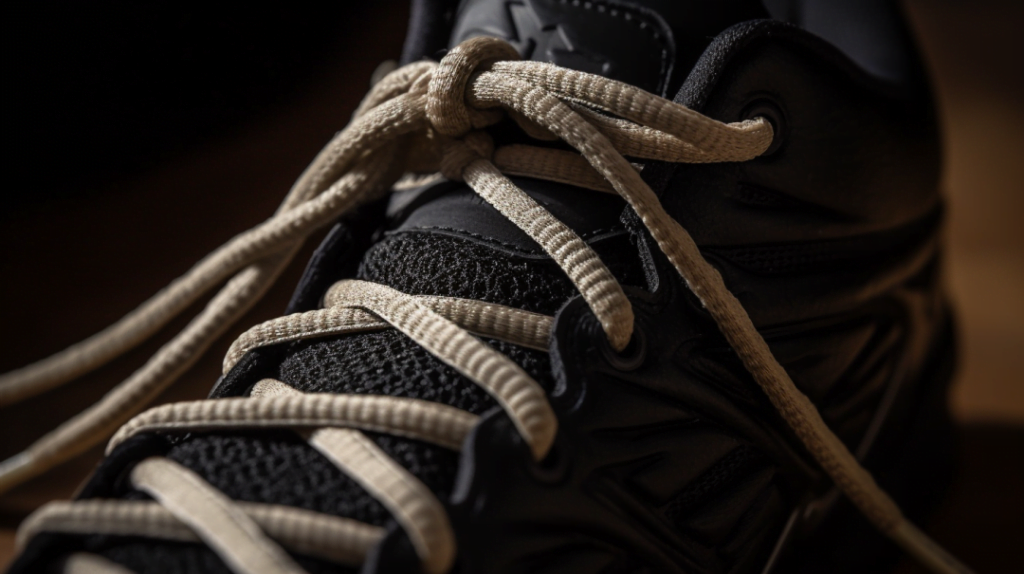
The Role of Brands and Shoe Types
Popular Brands: The Tightness Battle Royale
Volleyball shoes from Nike, Adidas, and Mizuno are abundant. Have you ever pondered how these giants design for optimum tightness? Join me for a tightness match!

Nike volleyball shoes are innovative. They commonly use Flywire wires for a tight, adjustable fit. Support and flexibility are combined in these sneakers to make your feet feel snug.
On the other hand, Adidas emphasizes stability and cushioning. Their volleyball shoes use torsion mechanisms to keep your foot in place during dynamic plays. Adidas volleyball shoes are like Swiss army knives: versatile and reliable.
Mizuno is the competition’s dark horse. Mizuno is noted for its fit details. They accommodate diverse foot shapes with varied widths. Like Cinderella’s glass slippers, Mizuno shoes may be the right fit.
Model Matters: Not All Volleyball Shoes Are Equal
Even within the same brand, volleyball shoes vary. Your model may greatly affect how simple it is to maintain good tightness. Some models have built-in features that make modifications easy, while others take more work.
Nike’s Zoom HyperAce series is lauded for its tight fit and clever lacing. These shoes are like a personal shoemaker. However, Adidas CrazyFlight sneakers are known for their stability and durability. The volleyball shoe equivalent of tanks
Mizuno Wave Lightning sneakers, with their perfect fit and lightweight construction, provide the finest. The Swiss army knives of volleyball shoes can handle any difficulty.
Conclusion
Summary: The Tightness Formula for Volleyball Success
We’ve covered a lot, huh? From shoe anatomy to tightness to professional advice, you’re ready to improve your volleyball game.
We now know that shoe tightness is the key to enhanced performance and foot health. Not simply fitting your feet into your shoes, but finding that sweet spot that helps you move like a ninja on the court.
Brands and shoe types also matter. Nike, Adidas, and Mizuno are all competing, but your requirements and tastes determine the best fit. Cinderella shoes are possible!
Frequently Asked Questions (FAQs)
Why does the tightness of volleyball shoes matter?
The tightness of volleyball shoes is crucial for performance and foot health. Properly fitting shoes can enhance agility, jumping ability, and overall gameplay. They also help prevent blisters, foot pain, and sprains, ensuring you stay in the game.
How do I find the right tightness for my volleyball shoes?
Use the “Thumb Rule” to check the fit. Your thumb should fit snugly between your biggest toe and the shoe’s tip. Additionally, consider your foot shape and the type of socks you wear, as these factors influence tightness.
Are there different types of volleyball shoe brands?
Yes, popular brands like Nike, Adidas, and Mizuno approach design differently. Nike focuses on a snug, customizable fit; Adidas emphasizes stability and cushioning; and Mizuno offers various width options for a detailed fit.
Can tightness affect the longevity of volleyball shoes?
Yes, improper tightness can accelerate wear and tear, reducing the shoe’s lifespan. It’s essential to maintain the right tightness to ensure your shoes perform well and last longer.
What’s the significance of double-knotting shoelaces?
Double-knotting shoelaces is a quick trick to prevent them from coming undone during play. It ensures you won’t trip over loose laces and disrupt your game.
How can I maintain the ideal tightness of my volleyball shoes during a game?
Make quick adjustments during timeouts or breaks if your shoes feel too loose or too tight. A double knot can help maintain the desired fit.
Does the brand and model of volleyball shoes matter for tightness?
Yes, different brands and models offer varying levels of tightness and support. Finding the right fit for your feet and playing style is essential for optimal performance.
Can tight shoes lead to foot problems?
Yes, excessively tight shoes can cause blisters, foot pain, and even sprains due to reduced blood circulation and restricted movement.
How can I ensure my volleyball shoes stay in good condition?
Proper maintenance includes pre-game rituals, in-game checks, and post-game care. These practices can extend the lifespan of your shoes and keep them in top shape.
What’s the key takeaway about volleyball shoe tightness?
Volleyball shoe tightness isn’t just about comfort; it’s a game-changer for performance, foot health, and cost-effectiveness. By paying attention to fit, you can improve your game and make your investment in quality shoes last longer.




